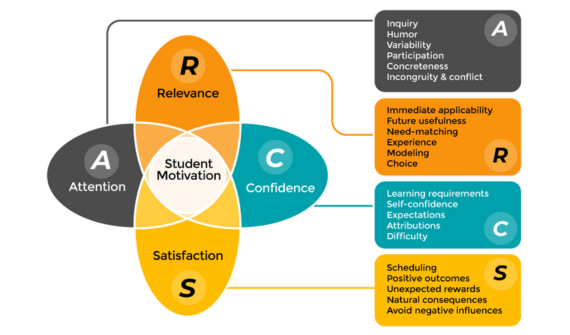The ARCS model of motivational design is a popular and widely used framework for designing effective learning experiences.
Developed by John Keller, the model is based on the idea that motivation is a key factor in learning and that instructional designers should focus on creating learning experiences that are motivating and compelling for learners.
The acronym ARCS stands for Attention, Relevance, Confidence, and Satisfaction, which are the four key components of the model.
In this comprehensive guide, we will dive deep into each component of the ARCS model.
Whether you are an instructional designer, educator, or training professional, this guide will provide you with valuable insights into the ARCS model of motivation.
What Is The ARCS Model Of Motivation?

The ARCS model of motivation is a framework developed by John Keller that provides a comprehensive approach to designing learning experiences that are engaging and motivating for learners.
The model is based on four key components: Attention, Relevance, Confidence, and Satisfaction.
Benefits Of The ARCS Model Of Instructional Design

The ARCS model of instructional design provides several benefits to instructional designers and learners alike.
Here are some of the key benefits in detail:
1. Increased Learner Motivation
The Keller ARCS model centers around designing learning experiences that captivate and inspire learners.
2. Heightened Learning Efficacy
Through the creation of learning experiences that align closely with learners' needs and interests, the model has the potential to amplify learning effectiveness.
Consequently, this can lead to enhanced knowledge and skill retention, as well as improved transfer and practical application.
3. Better Alignment With Learners' Goals And Needs
It emphasizes the importance of understanding learners' goals and needs and aligning the learning experience with them.
By doing so, instructional designers can create learning experiences that are more meaningful and relevant to learners, leading to greater satisfaction and success.
4. Increased Engagement And Participation
The Keller ARCS model incorporates strategies to capture learners' attention and maintain their engagement throughout the learning experience.
This can help to increase participation and interaction, leading to a more dynamic and collaborative learning environment.
5. Improved Learner Confidence And Self-Efficacy
It includes strategies to build learners' confidence and self-efficacy, such as providing clear instructions, feedback, and scaffolding.
This can help learners feel more competent and confident in their ability to learn and apply new knowledge and skills.
6. Flexibility And Adaptability
It is flexible and adaptable, allowing instructional designers to apply the framework to a wide range of learning contexts and modalities.
This can help to create learning experiences that are tailored to learners' needs and preferences, leading to greater engagement and success.
Overall, the ARCS model of instructional design offers a holistic and powerful framework for developing captivating and inspiring learning encounters.
By addressing the key components of Attention, Relevance, Confidence, and Satisfaction, instructional designers can enhance learning effectiveness, increase learner engagement and participation, and promote learner success and satisfaction.
Understanding The ARCS Model

The ARCS model of motivational design is a framework that instructional designers can use to create learning experiences that are meaningful and effective.
The model is based on four key components: Attention, Relevance, Confidence, and Satisfaction.
1. Attention
The first component, Attention, is about capturing the learners' attention and keeping them engaged in the learning process.
This is crucial because if learners are not paying attention, they are not learning.
To achieve this, instructional designers can use a variety of strategies, such as using multimedia, interactive activities, or humor.
Example
Instructional designers can employ videos, animations, or games to enhance the overall appeal and interactivity of the educational experience.
2. Relevance
The second component, Relevance, is about demonstrating the practical application of the content and its significance in the learners' lives.
This component aims to show learners how the learning experience relates to their goals, needs, and interests, and how it can be applied in real-life situations.
Instructional designers can achieve this by providing examples, case studies, or scenarios that demonstrate the relevance of the content.
Example
For instance, in business training, learners might be shown how to apply new negotiation techniques to real-world scenarios.
3. Confidence
The third component, Confidence, is about building learners' self-efficacy and sense of competence in their ability to learn and apply new knowledge and skills.
This component is essential because learners who lack confidence in their ability to learn may not be motivated to engage in the learning experience.
To build learners' confidence, instructional designers can provide clear instructions, and feedback, and use scaffolding.
Example
In a math course, instructional designers might provide step-by-step instructions and examples to help learners build their confidence.
4. Satisfaction
The fourth component, Satisfaction, aims to create a sense of accomplishment and reward for learners upon completion of the learning experience.
This component can be achieved by providing learners with opportunities to apply their new knowledge and skills in practical scenarios or by recognizing and rewarding their achievements.
Example
For instance, in a language learning course, learners might be given opportunities to practice their new language skills in real-life situations, such as through role-play exercises or conversations with native speakers.
The ARCS model is flexible and adaptable, allowing instructional designers to apply the framework to a wide range of learning contexts and modalities.
Design Learning Experiences With Oreed
Looking for a solution to manage your employees' training needs on a single platform?
Look no further than Oreed's Education Intelligence platform which offers an all-in-one solution.
1. Boost Employee Awareness
Oreed's platform enhances employee awareness and provides a comprehensive view of your workforce, allowing you to make well-informed, data-driven decisions that promote business success.
2. Tailored Training
Not only that, our platform allows you to create customized training courses that meet your employees' specific requirements, unlike generic courses that may not resonate with your team.
3. Track Training Impact
What's more, Oreed's platform lets you measure the impact and effectiveness of your training courses, providing you with valuable insights that can optimize your workforce's performance.
4. Assured Results
Looking for a transformative return on investment?
We guarantee a tenfold increase in customer revenue and engagement, along with enhanced employee productivity and organizational efficiency.
5. Effortless Tracking
This platform provides easy tracking and measurement of your progress, ensuring that you stay on course toward your objectives.
With Oreed's platform, you can say goodbye to mediocre outcomes and welcome unparalleled success.
So what are you waiting for? Book a demo with Oreed today and find out more about our features.
Promote lifelong learning through Oreed by experiencing the most powerful all-in-one training and development intelligent platform that streamlines all your organization's learning, training, and development activities in one place.
Final Thoughts
In conclusion, the ARCS model of motivational design proves to be a valuable framework for instructional designers to craft captivating, purposeful, and successful educational encounters.
The model assists instructional designers in crafting customized learning experiences that cater to learners' requirements and foster engagement, participation, and achievement by focusing on the fundamental aspects of Attention, Relevance, Confidence, and Satisfaction.
Moreover, the model is flexible and adaptable, allowing instructional designers to apply the framework to various learning contexts and modalities.
By leveraging the ARCS model, instructional designers can enhance the effectiveness of their learning programs, increase learner engagement and participation, and ultimately, achieve better learning outcomes.
FAQs
1. Why do we need arcs?
We require the ARCS model of motivational design because it provides instructional designers with a systematic framework to create captivating and effective educational interventions that motivate learners to acquire knowledge and achieve their goals.
The model addresses four key components of motivation: Attention, Relevance, Confidence, and Satisfaction, and provides strategies and techniques for promoting each of these elements in instructional design.
By applying the model, instructional designers can create learning experiences that capture learners' attention, demonstrate the relevance of the content to learners' goals and interests, build learners' confidence and competence, and provide feedback and reinforcement that satisfies learners' needs for achievement and recognition.
This can result in increased learner motivation, engagement, participation, and success, ultimately leading to better learning outcomes.
2. Is this model effective?
Yes, the ARCS model has proven to be highly effective in instructional design. It provides a comprehensive framework for creating learning experiences that are captivating, motivating, and tailored to learners' needs.
The model has been extensively researched and has demonstrated its effectiveness in various learning contexts and modalities.





